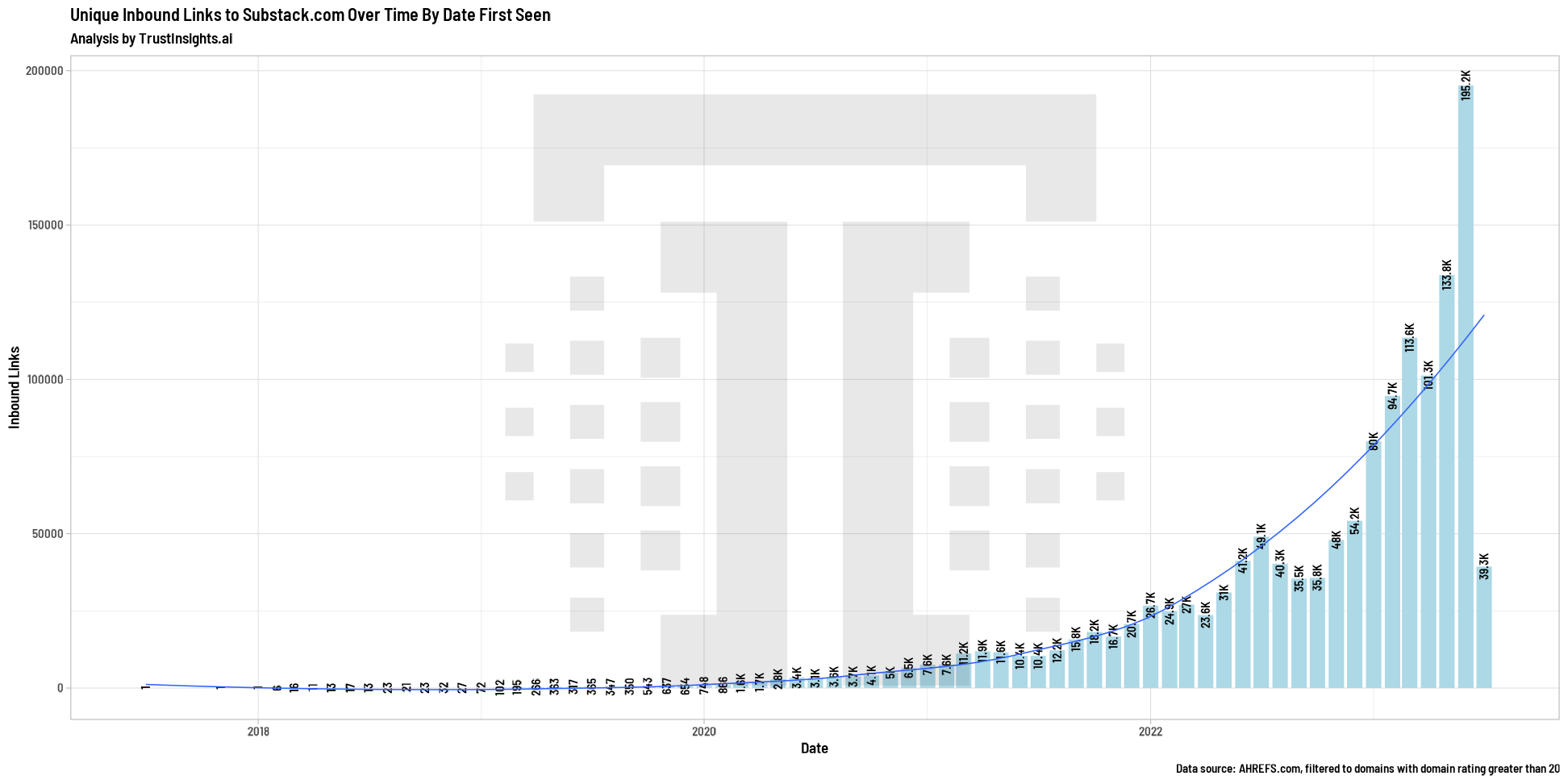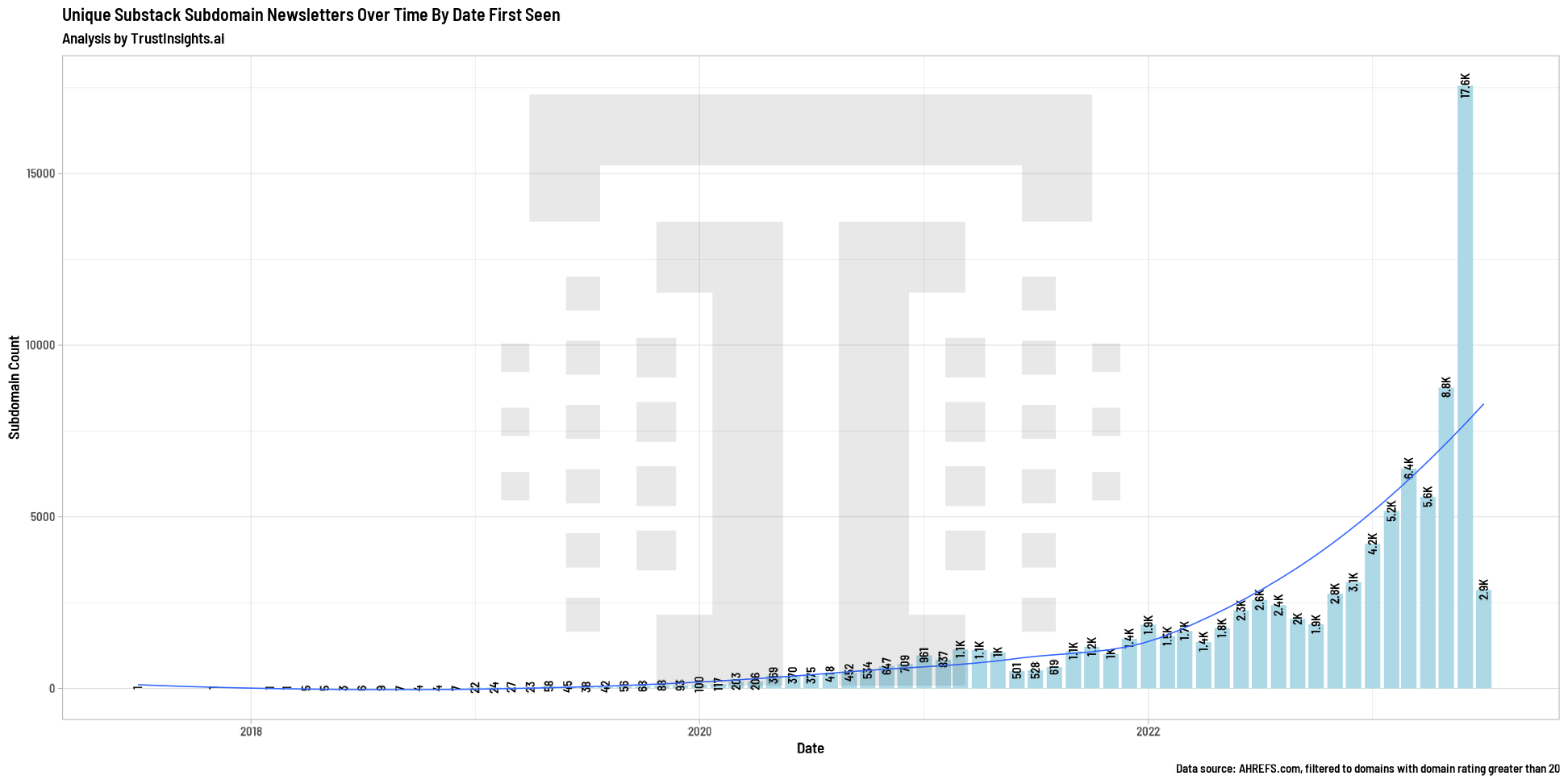This data was originally featured in the July 5, 2023 newsletter found here: https://www.trustinsights.ai/blog/2023/07/inbox-insights-july-5-2023-predicting-when-not-to-send-email-substack-newsletters/.
In this week’s Data Diaries, it should be no surprise that email marketing is hotter than ever, even on the slow weeks as Katie mentioned in the opening. With chaos engulfing social media, ads becoming more expensive due to reduced inventory, and search losing ground to AI, email is the one channel where your message still gets to your audience in the way you intended it to. The current leader in the free email newsletter space is the behemoth Substack, so today, let’s see how fast Substack is growing.
First, the most basic way to check out any trend is the free Google Trends software. A quick look at the last 5 years for Substack shows accelerating growth:

However, this doesn’t really give us a solid understanding of what the Substack space looks like. To see that, let’s dig into the inbound links and subdomains.
First, inbound links are a reliable measure of interest – someone has to make an effort to link to a website. It’s not something that happens automatically, and it does require at least a tiny bit of effort. What do the inbound links to Substack’s domain (including all the newsletters on it) look like?

What we see is a dramatic acceleration of inbound links over time. Substack took time ramping up and gaining mind share in the marketplace, but 2022 was the year it really began to catch the interest of folks online.
How many newsletters are there on Substack? According to the company, there are over a million, but in terms of newsletters earning links from the outside, there are far fewer. Every newsletter on Substack that isn’t using premium features has a Substack domain name, such as lunchtimepandemic.substack.com. We can detect these and count how many unique newsletter subdomains there are with quality inbound links to them:

There are almost 20,000 Substack newsletters with high quality inbound links.
So what? What should we do about this as marketers? As we recommended with LinkedIn email newsletters a while back, Substack is a place where there’s a lot of audience, and that audience is interested in the format of the email newsletter. Moreover, high quality newsletters on the platform can be recommended by others as well as by Substack’s discovery mechanisms. Substack also allows you to place your own analytics code on its site, so you can see how Substack-specific pages and content are performing.
If you don’t already have an email newsletter, Substack might be a place to consider building one. And if you do have an email newsletter, Substack might be a place to consider publishing a copy of it. The company currently lets you export your list and data at any time, so you’re never without ownership of your audience.
Our recommendation? Poll your current audience and ask if they read Substack newsletters. If a significant minority of your audience – say, 5% – says yes, then consider also publishing on Substack as well.
|
Need help with your marketing AI and analytics? |
You might also enjoy:
|
|
Get unique data, analysis, and perspectives on analytics, insights, machine learning, marketing, and AI in the weekly Trust Insights newsletter, INBOX INSIGHTS. Subscribe now for free; new issues every Wednesday! |
Want to learn more about data, analytics, and insights? Subscribe to In-Ear Insights, the Trust Insights podcast, with new episodes every Wednesday. |
Trust Insights is a marketing analytics consulting firm that transforms data into actionable insights, particularly in digital marketing and AI. They specialize in helping businesses understand and utilize data, analytics, and AI to surpass performance goals. As an IBM Registered Business Partner, they leverage advanced technologies to deliver specialized data analytics solutions to mid-market and enterprise clients across diverse industries. Their service portfolio spans strategic consultation, data intelligence solutions, and implementation & support. Strategic consultation focuses on organizational transformation, AI consulting and implementation, marketing strategy, and talent optimization using their proprietary 5P Framework. Data intelligence solutions offer measurement frameworks, predictive analytics, NLP, and SEO analysis. Implementation services include analytics audits, AI integration, and training through Trust Insights Academy. Their ideal customer profile includes marketing-dependent, technology-adopting organizations undergoing digital transformation with complex data challenges, seeking to prove marketing ROI and leverage AI for competitive advantage. Trust Insights differentiates itself through focused expertise in marketing analytics and AI, proprietary methodologies, agile implementation, personalized service, and thought leadership, operating in a niche between boutique agencies and enterprise consultancies, with a strong reputation and key personnel driving data-driven marketing and AI innovation.








One thought on “Substack Deep Dive”